University Project Report: Health and Social Care - Hypertension Study
VerifiedAdded on 2021/04/17
|9
|1511
|38
Project
AI Summary
This project report provides an in-depth analysis of hypertension, a chronic medical condition. It begins with an introduction and a disease brief, defining hypertension and its impact. The report then explores the human body's structure in relation to the disease, detailing how hypertension affects blood circulation and leads to various symptoms such as headaches, fatigue, and swelling. The physiology and function of the body are discussed, including the factors affecting arterial pressure and the role of cardiac output and peripheral resistance. Homeostatic mechanisms, particularly blood pressure regulation, are examined to understand how the body maintains internal stability. The report further investigates the causes, signs, and symptoms of hypertension, categorizing them based on blood pressure levels and providing a table of symptoms. Finally, the report concludes by emphasizing the importance of timely blood pressure checks for diagnosis and includes a comprehensive list of references.
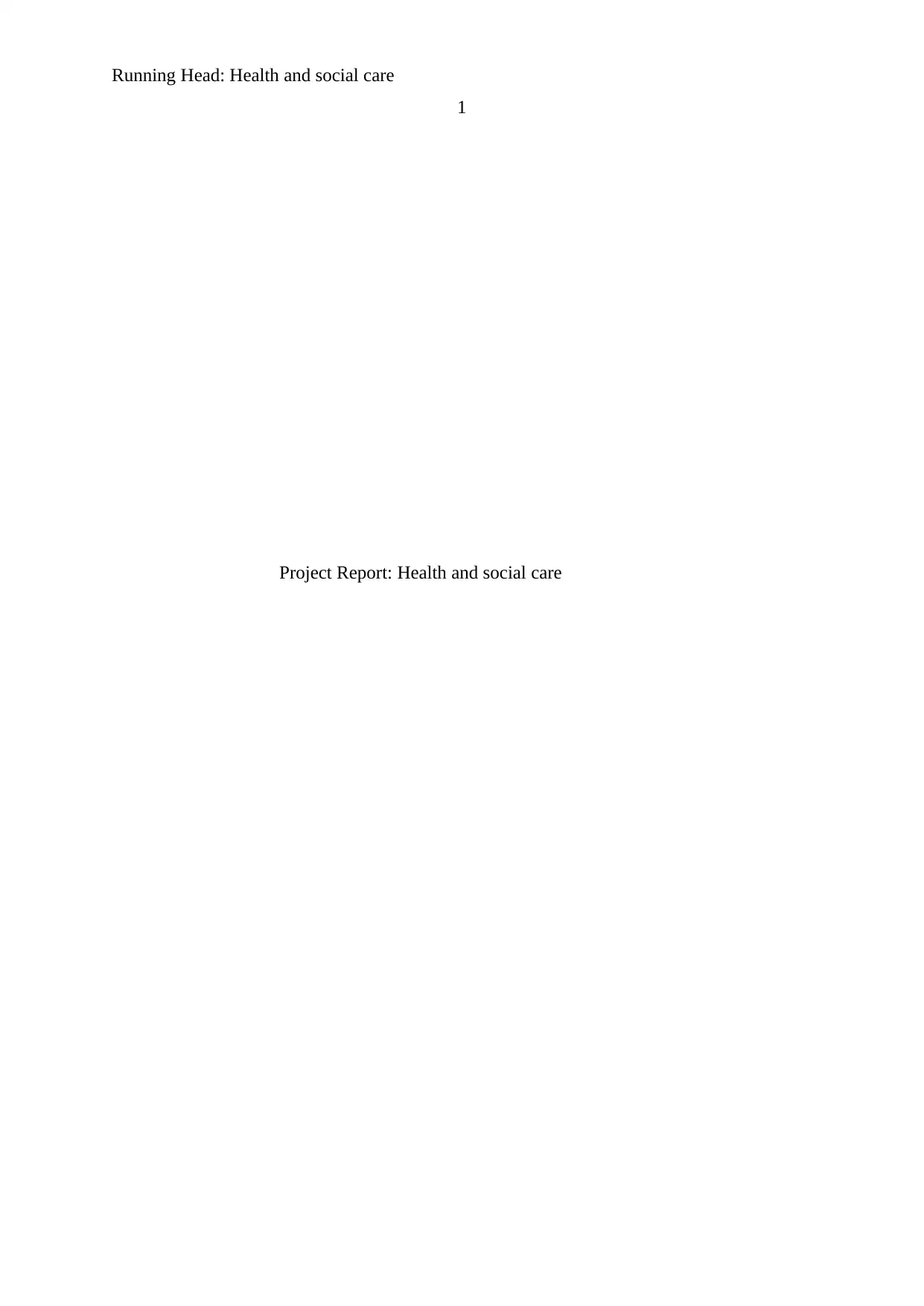
Running Head: Health and social care
1
Project Report: Health and social care
1
Project Report: Health and social care
Paraphrase This Document
Need a fresh take? Get an instant paraphrase of this document with our AI Paraphraser
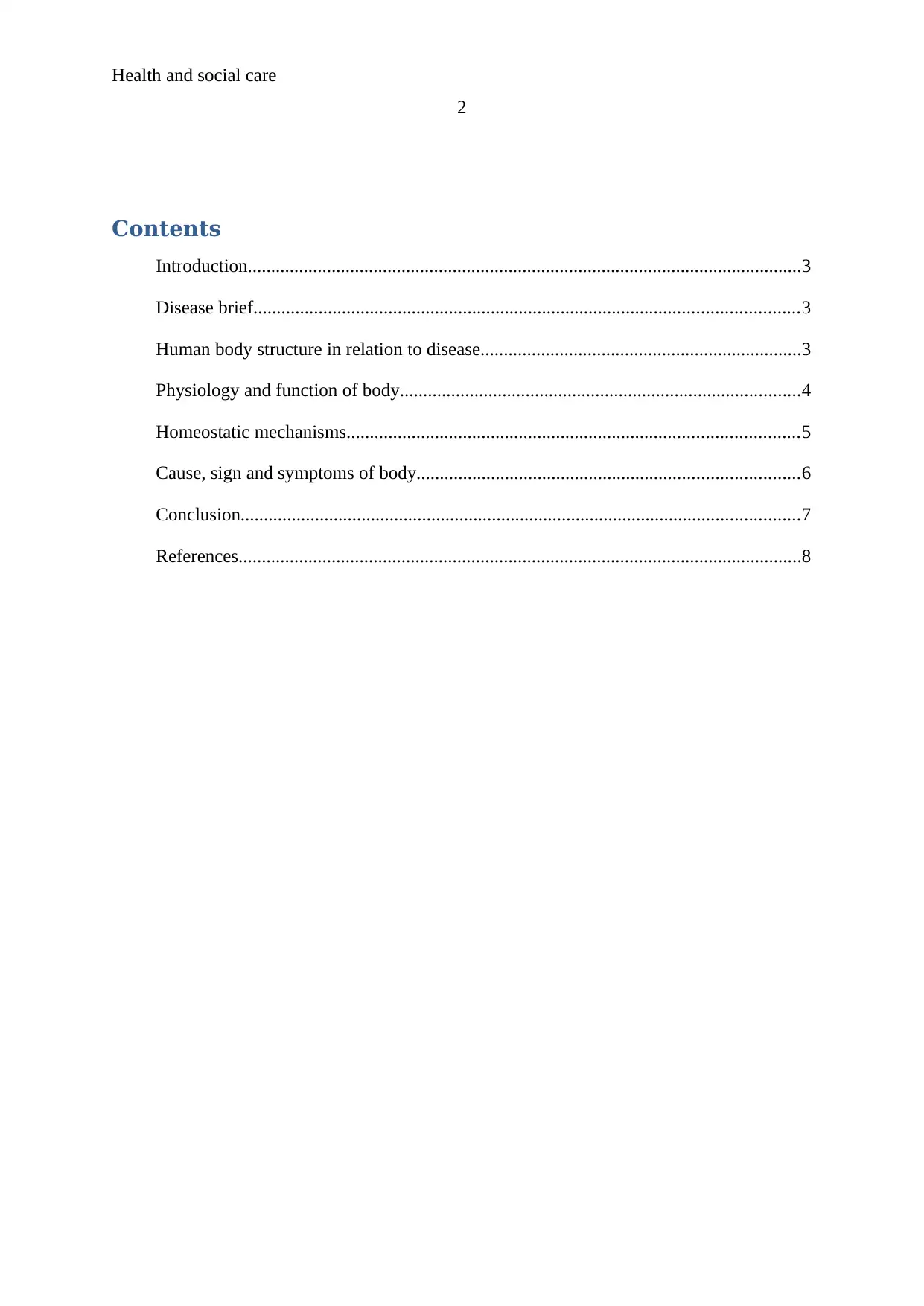
Health and social care
2
Contents
Introduction.......................................................................................................................3
Disease brief.....................................................................................................................3
Human body structure in relation to disease.....................................................................3
Physiology and function of body......................................................................................4
Homeostatic mechanisms.................................................................................................5
Cause, sign and symptoms of body..................................................................................6
Conclusion........................................................................................................................7
References.........................................................................................................................8
2
Contents
Introduction.......................................................................................................................3
Disease brief.....................................................................................................................3
Human body structure in relation to disease.....................................................................3
Physiology and function of body......................................................................................4
Homeostatic mechanisms.................................................................................................5
Cause, sign and symptoms of body..................................................................................6
Conclusion........................................................................................................................7
References.........................................................................................................................8
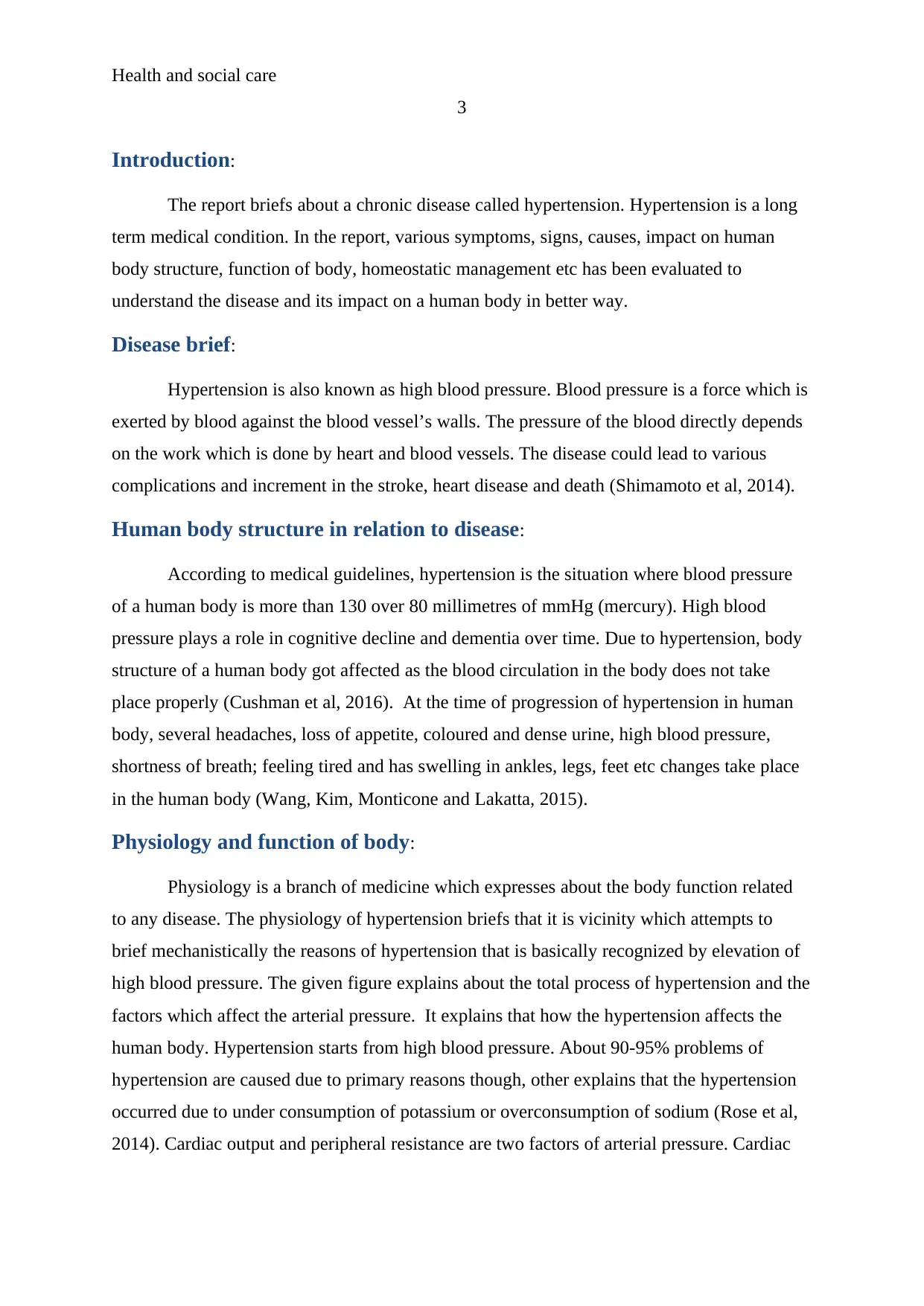
Health and social care
3
Introduction:
The report briefs about a chronic disease called hypertension. Hypertension is a long
term medical condition. In the report, various symptoms, signs, causes, impact on human
body structure, function of body, homeostatic management etc has been evaluated to
understand the disease and its impact on a human body in better way.
Disease brief:
Hypertension is also known as high blood pressure. Blood pressure is a force which is
exerted by blood against the blood vessel’s walls. The pressure of the blood directly depends
on the work which is done by heart and blood vessels. The disease could lead to various
complications and increment in the stroke, heart disease and death (Shimamoto et al, 2014).
Human body structure in relation to disease:
According to medical guidelines, hypertension is the situation where blood pressure
of a human body is more than 130 over 80 millimetres of mmHg (mercury). High blood
pressure plays a role in cognitive decline and dementia over time. Due to hypertension, body
structure of a human body got affected as the blood circulation in the body does not take
place properly (Cushman et al, 2016). At the time of progression of hypertension in human
body, several headaches, loss of appetite, coloured and dense urine, high blood pressure,
shortness of breath; feeling tired and has swelling in ankles, legs, feet etc changes take place
in the human body (Wang, Kim, Monticone and Lakatta, 2015).
Physiology and function of body:
Physiology is a branch of medicine which expresses about the body function related
to any disease. The physiology of hypertension briefs that it is vicinity which attempts to
brief mechanistically the reasons of hypertension that is basically recognized by elevation of
high blood pressure. The given figure explains about the total process of hypertension and the
factors which affect the arterial pressure. It explains that how the hypertension affects the
human body. Hypertension starts from high blood pressure. About 90-95% problems of
hypertension are caused due to primary reasons though, other explains that the hypertension
occurred due to under consumption of potassium or overconsumption of sodium (Rose et al,
2014). Cardiac output and peripheral resistance are two factors of arterial pressure. Cardiac
3
Introduction:
The report briefs about a chronic disease called hypertension. Hypertension is a long
term medical condition. In the report, various symptoms, signs, causes, impact on human
body structure, function of body, homeostatic management etc has been evaluated to
understand the disease and its impact on a human body in better way.
Disease brief:
Hypertension is also known as high blood pressure. Blood pressure is a force which is
exerted by blood against the blood vessel’s walls. The pressure of the blood directly depends
on the work which is done by heart and blood vessels. The disease could lead to various
complications and increment in the stroke, heart disease and death (Shimamoto et al, 2014).
Human body structure in relation to disease:
According to medical guidelines, hypertension is the situation where blood pressure
of a human body is more than 130 over 80 millimetres of mmHg (mercury). High blood
pressure plays a role in cognitive decline and dementia over time. Due to hypertension, body
structure of a human body got affected as the blood circulation in the body does not take
place properly (Cushman et al, 2016). At the time of progression of hypertension in human
body, several headaches, loss of appetite, coloured and dense urine, high blood pressure,
shortness of breath; feeling tired and has swelling in ankles, legs, feet etc changes take place
in the human body (Wang, Kim, Monticone and Lakatta, 2015).
Physiology and function of body:
Physiology is a branch of medicine which expresses about the body function related
to any disease. The physiology of hypertension briefs that it is vicinity which attempts to
brief mechanistically the reasons of hypertension that is basically recognized by elevation of
high blood pressure. The given figure explains about the total process of hypertension and the
factors which affect the arterial pressure. It explains that how the hypertension affects the
human body. Hypertension starts from high blood pressure. About 90-95% problems of
hypertension are caused due to primary reasons though, other explains that the hypertension
occurred due to under consumption of potassium or overconsumption of sodium (Rose et al,
2014). Cardiac output and peripheral resistance are two factors of arterial pressure. Cardiac
⊘ This is a preview!⊘
Do you want full access?
Subscribe today to unlock all pages.

Trusted by 1+ million students worldwide
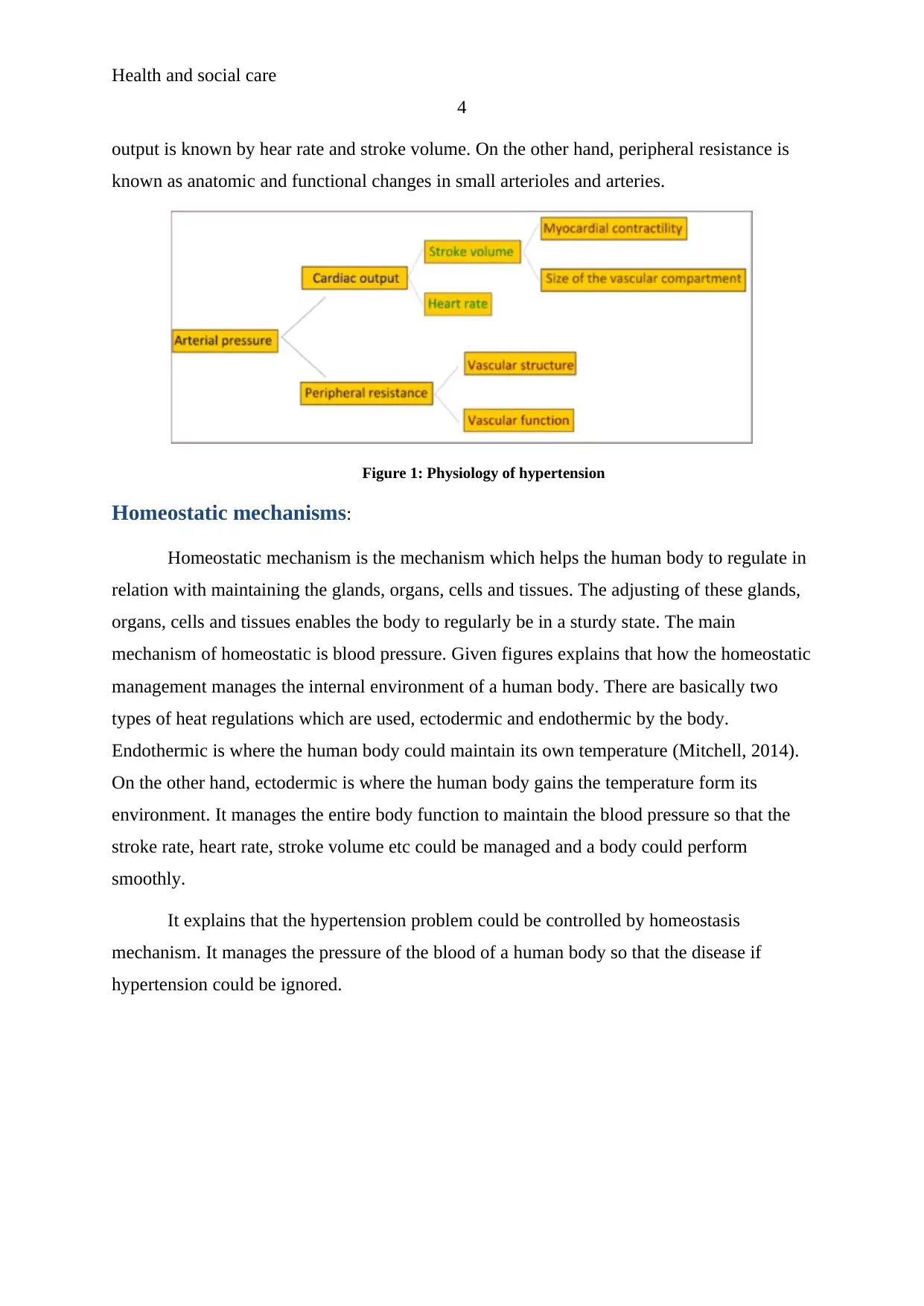
Health and social care
4
output is known by hear rate and stroke volume. On the other hand, peripheral resistance is
known as anatomic and functional changes in small arterioles and arteries.
Figure 1: Physiology of hypertension
Homeostatic mechanisms:
Homeostatic mechanism is the mechanism which helps the human body to regulate in
relation with maintaining the glands, organs, cells and tissues. The adjusting of these glands,
organs, cells and tissues enables the body to regularly be in a sturdy state. The main
mechanism of homeostatic is blood pressure. Given figures explains that how the homeostatic
management manages the internal environment of a human body. There are basically two
types of heat regulations which are used, ectodermic and endothermic by the body.
Endothermic is where the human body could maintain its own temperature (Mitchell, 2014).
On the other hand, ectodermic is where the human body gains the temperature form its
environment. It manages the entire body function to maintain the blood pressure so that the
stroke rate, heart rate, stroke volume etc could be managed and a body could perform
smoothly.
It explains that the hypertension problem could be controlled by homeostasis
mechanism. It manages the pressure of the blood of a human body so that the disease if
hypertension could be ignored.
4
output is known by hear rate and stroke volume. On the other hand, peripheral resistance is
known as anatomic and functional changes in small arterioles and arteries.
Figure 1: Physiology of hypertension
Homeostatic mechanisms:
Homeostatic mechanism is the mechanism which helps the human body to regulate in
relation with maintaining the glands, organs, cells and tissues. The adjusting of these glands,
organs, cells and tissues enables the body to regularly be in a sturdy state. The main
mechanism of homeostatic is blood pressure. Given figures explains that how the homeostatic
management manages the internal environment of a human body. There are basically two
types of heat regulations which are used, ectodermic and endothermic by the body.
Endothermic is where the human body could maintain its own temperature (Mitchell, 2014).
On the other hand, ectodermic is where the human body gains the temperature form its
environment. It manages the entire body function to maintain the blood pressure so that the
stroke rate, heart rate, stroke volume etc could be managed and a body could perform
smoothly.
It explains that the hypertension problem could be controlled by homeostasis
mechanism. It manages the pressure of the blood of a human body so that the disease if
hypertension could be ignored.
Paraphrase This Document
Need a fresh take? Get an instant paraphrase of this document with our AI Paraphraser
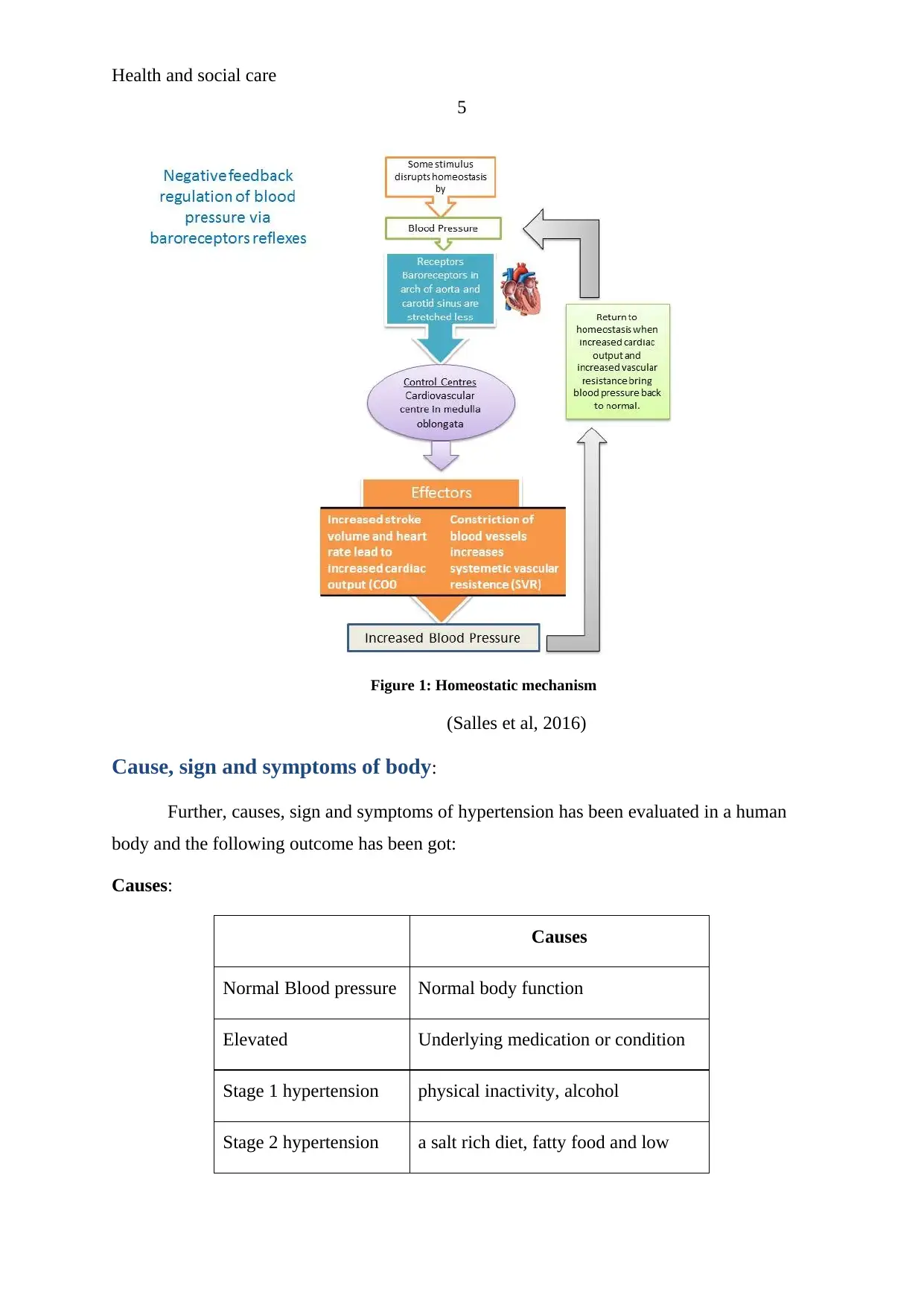
Health and social care
5
Figure 1: Homeostatic mechanism
(Salles et al, 2016)
Cause, sign and symptoms of body:
Further, causes, sign and symptoms of hypertension has been evaluated in a human
body and the following outcome has been got:
Causes:
Causes
Normal Blood pressure Normal body function
Elevated Underlying medication or condition
Stage 1 hypertension physical inactivity, alcohol
Stage 2 hypertension a salt rich diet, fatty food and low
5
Figure 1: Homeostatic mechanism
(Salles et al, 2016)
Cause, sign and symptoms of body:
Further, causes, sign and symptoms of hypertension has been evaluated in a human
body and the following outcome has been got:
Causes:
Causes
Normal Blood pressure Normal body function
Elevated Underlying medication or condition
Stage 1 hypertension physical inactivity, alcohol
Stage 2 hypertension a salt rich diet, fatty food and low
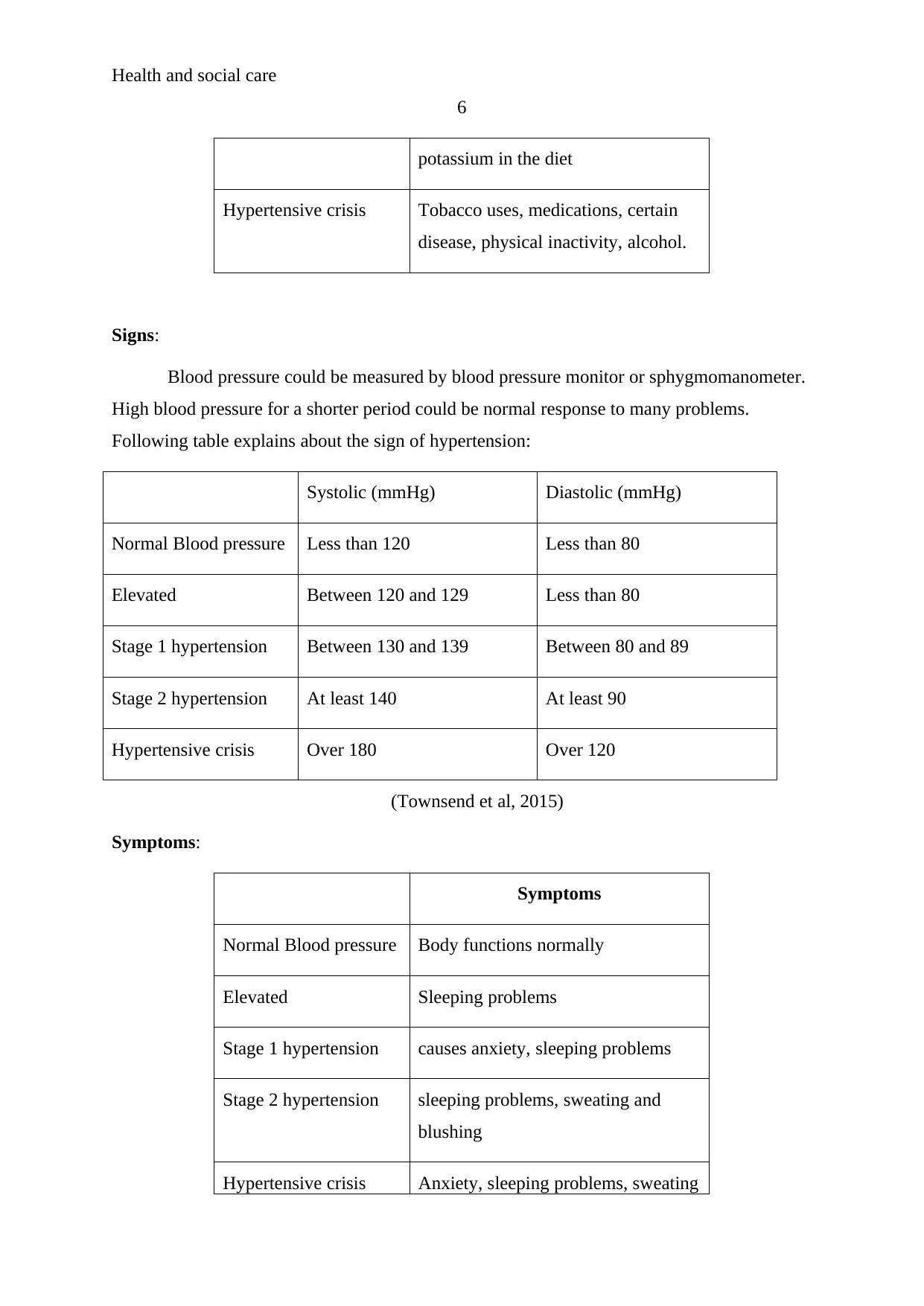
Health and social care
6
potassium in the diet
Hypertensive crisis Tobacco uses, medications, certain
disease, physical inactivity, alcohol.
Signs:
Blood pressure could be measured by blood pressure monitor or sphygmomanometer.
High blood pressure for a shorter period could be normal response to many problems.
Following table explains about the sign of hypertension:
Systolic (mmHg) Diastolic (mmHg)
Normal Blood pressure Less than 120 Less than 80
Elevated Between 120 and 129 Less than 80
Stage 1 hypertension Between 130 and 139 Between 80 and 89
Stage 2 hypertension At least 140 At least 90
Hypertensive crisis Over 180 Over 120
(Townsend et al, 2015)
Symptoms:
Symptoms
Normal Blood pressure Body functions normally
Elevated Sleeping problems
Stage 1 hypertension causes anxiety, sleeping problems
Stage 2 hypertension sleeping problems, sweating and
blushing
Hypertensive crisis Anxiety, sleeping problems, sweating
6
potassium in the diet
Hypertensive crisis Tobacco uses, medications, certain
disease, physical inactivity, alcohol.
Signs:
Blood pressure could be measured by blood pressure monitor or sphygmomanometer.
High blood pressure for a shorter period could be normal response to many problems.
Following table explains about the sign of hypertension:
Systolic (mmHg) Diastolic (mmHg)
Normal Blood pressure Less than 120 Less than 80
Elevated Between 120 and 129 Less than 80
Stage 1 hypertension Between 130 and 139 Between 80 and 89
Stage 2 hypertension At least 140 At least 90
Hypertensive crisis Over 180 Over 120
(Townsend et al, 2015)
Symptoms:
Symptoms
Normal Blood pressure Body functions normally
Elevated Sleeping problems
Stage 1 hypertension causes anxiety, sleeping problems
Stage 2 hypertension sleeping problems, sweating and
blushing
Hypertensive crisis Anxiety, sleeping problems, sweating
⊘ This is a preview!⊘
Do you want full access?
Subscribe today to unlock all pages.

Trusted by 1+ million students worldwide
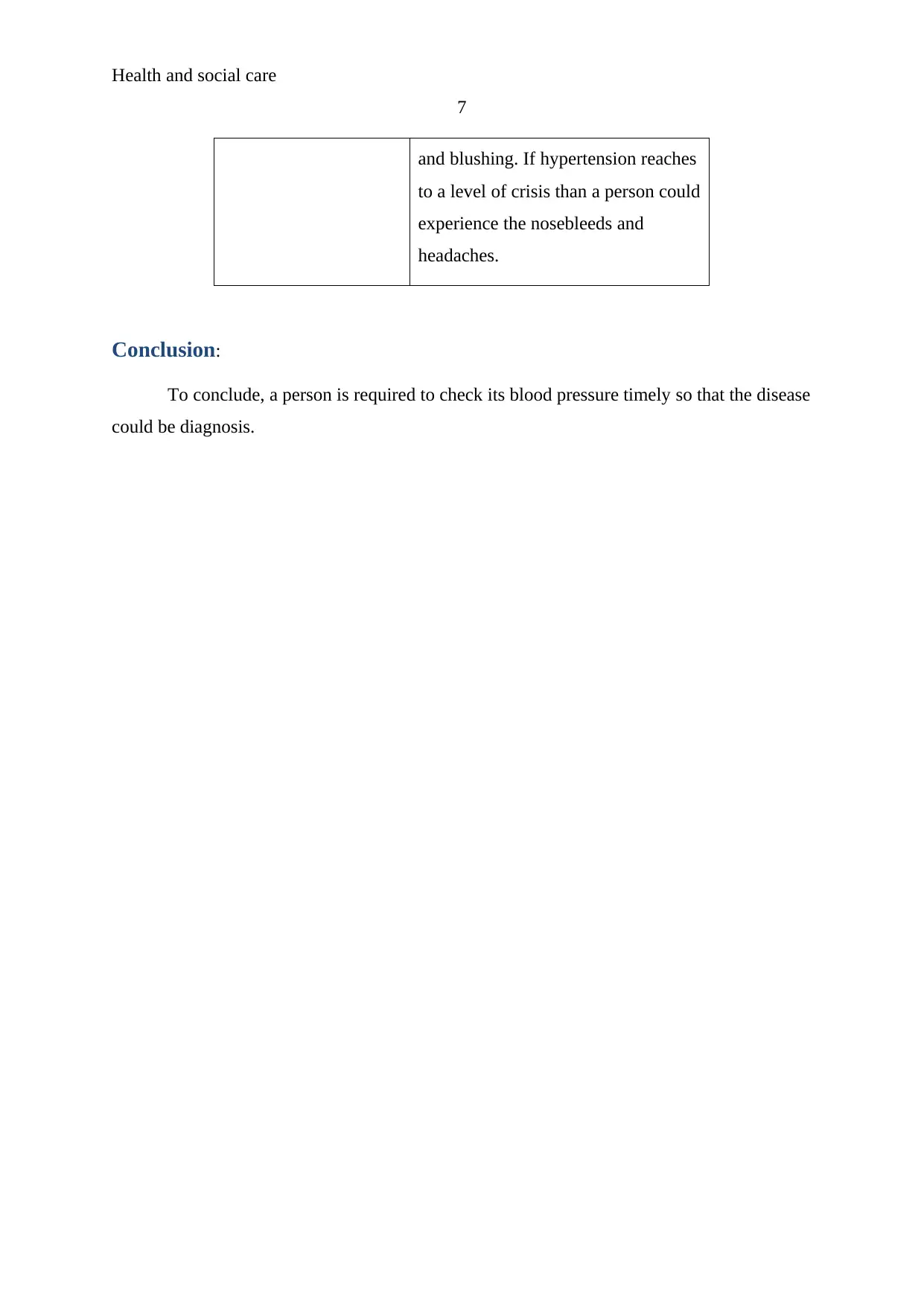
Health and social care
7
and blushing. If hypertension reaches
to a level of crisis than a person could
experience the nosebleeds and
headaches.
Conclusion:
To conclude, a person is required to check its blood pressure timely so that the disease
could be diagnosis.
7
and blushing. If hypertension reaches
to a level of crisis than a person could
experience the nosebleeds and
headaches.
Conclusion:
To conclude, a person is required to check its blood pressure timely so that the disease
could be diagnosis.
Paraphrase This Document
Need a fresh take? Get an instant paraphrase of this document with our AI Paraphraser
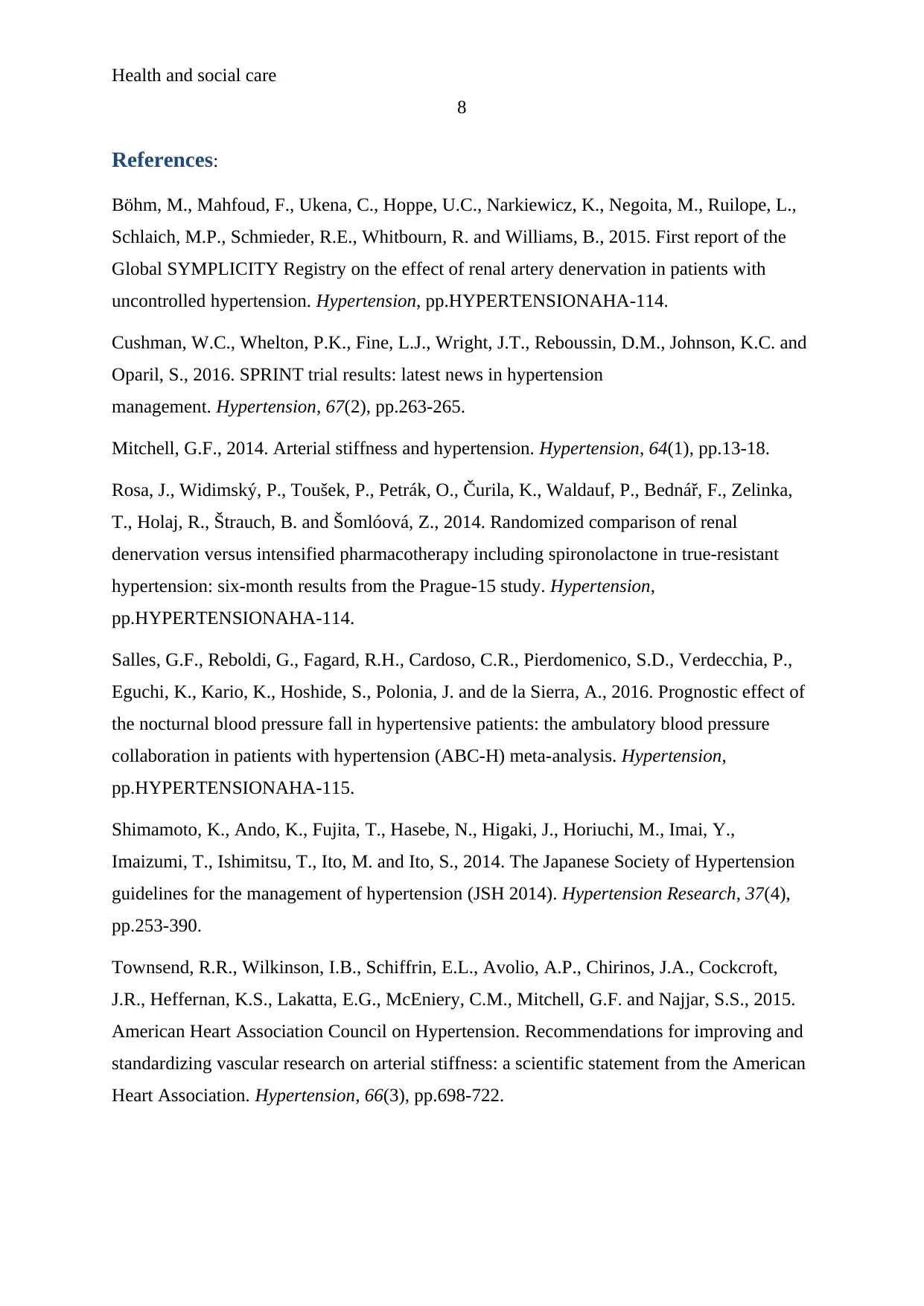
Health and social care
8
References:
Böhm, M., Mahfoud, F., Ukena, C., Hoppe, U.C., Narkiewicz, K., Negoita, M., Ruilope, L.,
Schlaich, M.P., Schmieder, R.E., Whitbourn, R. and Williams, B., 2015. First report of the
Global SYMPLICITY Registry on the effect of renal artery denervation in patients with
uncontrolled hypertension. Hypertension, pp.HYPERTENSIONAHA-114.
Cushman, W.C., Whelton, P.K., Fine, L.J., Wright, J.T., Reboussin, D.M., Johnson, K.C. and
Oparil, S., 2016. SPRINT trial results: latest news in hypertension
management. Hypertension, 67(2), pp.263-265.
Mitchell, G.F., 2014. Arterial stiffness and hypertension. Hypertension, 64(1), pp.13-18.
Rosa, J., Widimský, P., Toušek, P., Petrák, O., Čurila, K., Waldauf, P., Bednář, F., Zelinka,
T., Holaj, R., Štrauch, B. and Šomlóová, Z., 2014. Randomized comparison of renal
denervation versus intensified pharmacotherapy including spironolactone in true-resistant
hypertension: six-month results from the Prague-15 study. Hypertension,
pp.HYPERTENSIONAHA-114.
Salles, G.F., Reboldi, G., Fagard, R.H., Cardoso, C.R., Pierdomenico, S.D., Verdecchia, P.,
Eguchi, K., Kario, K., Hoshide, S., Polonia, J. and de la Sierra, A., 2016. Prognostic effect of
the nocturnal blood pressure fall in hypertensive patients: the ambulatory blood pressure
collaboration in patients with hypertension (ABC-H) meta-analysis. Hypertension,
pp.HYPERTENSIONAHA-115.
Shimamoto, K., Ando, K., Fujita, T., Hasebe, N., Higaki, J., Horiuchi, M., Imai, Y.,
Imaizumi, T., Ishimitsu, T., Ito, M. and Ito, S., 2014. The Japanese Society of Hypertension
guidelines for the management of hypertension (JSH 2014). Hypertension Research, 37(4),
pp.253-390.
Townsend, R.R., Wilkinson, I.B., Schiffrin, E.L., Avolio, A.P., Chirinos, J.A., Cockcroft,
J.R., Heffernan, K.S., Lakatta, E.G., McEniery, C.M., Mitchell, G.F. and Najjar, S.S., 2015.
American Heart Association Council on Hypertension. Recommendations for improving and
standardizing vascular research on arterial stiffness: a scientific statement from the American
Heart Association. Hypertension, 66(3), pp.698-722.
8
References:
Böhm, M., Mahfoud, F., Ukena, C., Hoppe, U.C., Narkiewicz, K., Negoita, M., Ruilope, L.,
Schlaich, M.P., Schmieder, R.E., Whitbourn, R. and Williams, B., 2015. First report of the
Global SYMPLICITY Registry on the effect of renal artery denervation in patients with
uncontrolled hypertension. Hypertension, pp.HYPERTENSIONAHA-114.
Cushman, W.C., Whelton, P.K., Fine, L.J., Wright, J.T., Reboussin, D.M., Johnson, K.C. and
Oparil, S., 2016. SPRINT trial results: latest news in hypertension
management. Hypertension, 67(2), pp.263-265.
Mitchell, G.F., 2014. Arterial stiffness and hypertension. Hypertension, 64(1), pp.13-18.
Rosa, J., Widimský, P., Toušek, P., Petrák, O., Čurila, K., Waldauf, P., Bednář, F., Zelinka,
T., Holaj, R., Štrauch, B. and Šomlóová, Z., 2014. Randomized comparison of renal
denervation versus intensified pharmacotherapy including spironolactone in true-resistant
hypertension: six-month results from the Prague-15 study. Hypertension,
pp.HYPERTENSIONAHA-114.
Salles, G.F., Reboldi, G., Fagard, R.H., Cardoso, C.R., Pierdomenico, S.D., Verdecchia, P.,
Eguchi, K., Kario, K., Hoshide, S., Polonia, J. and de la Sierra, A., 2016. Prognostic effect of
the nocturnal blood pressure fall in hypertensive patients: the ambulatory blood pressure
collaboration in patients with hypertension (ABC-H) meta-analysis. Hypertension,
pp.HYPERTENSIONAHA-115.
Shimamoto, K., Ando, K., Fujita, T., Hasebe, N., Higaki, J., Horiuchi, M., Imai, Y.,
Imaizumi, T., Ishimitsu, T., Ito, M. and Ito, S., 2014. The Japanese Society of Hypertension
guidelines for the management of hypertension (JSH 2014). Hypertension Research, 37(4),
pp.253-390.
Townsend, R.R., Wilkinson, I.B., Schiffrin, E.L., Avolio, A.P., Chirinos, J.A., Cockcroft,
J.R., Heffernan, K.S., Lakatta, E.G., McEniery, C.M., Mitchell, G.F. and Najjar, S.S., 2015.
American Heart Association Council on Hypertension. Recommendations for improving and
standardizing vascular research on arterial stiffness: a scientific statement from the American
Heart Association. Hypertension, 66(3), pp.698-722.

Health and social care
9
Wang, M., Kim, S.H., Monticone, R.E. and Lakatta, E.G., 2015. Matrix metalloproteinases
promote arterial remodeling in aging, hypertension, and atherosclerosis. Hypertension, 65(4),
pp.698-703.
9
Wang, M., Kim, S.H., Monticone, R.E. and Lakatta, E.G., 2015. Matrix metalloproteinases
promote arterial remodeling in aging, hypertension, and atherosclerosis. Hypertension, 65(4),
pp.698-703.
⊘ This is a preview!⊘
Do you want full access?
Subscribe today to unlock all pages.

Trusted by 1+ million students worldwide
1 out of 9
Related Documents
Your All-in-One AI-Powered Toolkit for Academic Success.
+13062052269
info@desklib.com
Available 24*7 on WhatsApp / Email
![[object Object]](/_next/static/media/star-bottom.7253800d.svg)
Unlock your academic potential
Copyright © 2020–2025 A2Z Services. All Rights Reserved. Developed and managed by ZUCOL.




